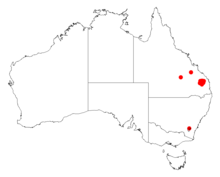Acacia anastomosa, also known as Carson River wattle, is a shrub belonging to the genus Acacia and the subgenus Juliflorae that is endemic to north western Australia.

Acacia chrysochaeta is a shrub belonging to the genus Acacia and the subgenus Juliflorae that is endemic to a small area of north western Australia.

Acacia pellita is a shrub or tree belonging to the genus Acacia and the subgenus Juliflorae that is endemic to parts of tropical northern Australia.

Acacia ramulosa, commonly known as horse mulga or bowgada wattle, is a shrub belonging to the genus Acacia and the subgenus Juliflorae endemic to arid areas of Australia.

Acacia obovata is a shrub belonging to the genus Acacia and the subgenus Phyllodineae that is endemic to south western Australia.

Acacia recurvata, commonly known as the recurved wattle, is a shrub of the genus Acacia and the subgenus Plurinerves that is endemic to a small area of western Australia.

Acacia veronica, commonly known as Veronica's wattle, is a shrub or tree of the genus Acacia and the subgenus Plurinerves that is endemic to a small area of south western Australia.

Acacia calantha is a shrub belonging to the genus Acacia and the subgenus Phyllodineae native to Queensland in Australia.

Acacia conferta, commonly known as crowded-leaf wattle, is a shrub belonging to the genus Acacia and the subgenus Phyllodineae that is endemic to eastern Australia.

Acacia fasciculifera, commonly known as scrub ironbark or less frequently as rosewood, is a tree belonging to the genus Acacia and the subgenus Phyllodineae endemic to parts of Queensland.

Acacia islana is a shrub belonging to the genus Acacia and the subgenus Phyllodineae that is native to parts of north eastern Australia.

Acacia pubicosta is a tree or shrub belonging to the genus Acacia and the subgenus Phyllodineae native to north eastern Australia.

Acacia barakulensis, commonly known as waajie wattle, is a shrub belonging to the genus Acacia and the subgenus Juliflorae that is native to north eastern Australia.

Acacia leptostachya, commonly known as Townsville wattle or slender wattle, is a shrub or small tree belonging to the genus Acacia and the subgenus Juliflorae that is native to north eastern Australia.

Acacia multistipulosa is a shrub or tree belonging to the genus Acacia and the subgenus Juliflorae that is native to northern Australia.

Acacia sericoflorais a shrub or tree belonging to the genus Acacia and the subgenus Juliflorae that is native to northern Australia.

Acacia solenota is a shrub belonging to the genus Acacia and the subgenus Juliflorae that is endemic to north eastern Australia. The species was listed as vulnerable under the Environment Protection and Biodiversity Conservation Act 1999 in 2008.

Acacia pycnostachya, also known as Bolivia wattle, is a shrub or tree belonging to the genus Acacia and the subgenus Juliflorae that is native to eastern Australia.
Acacia argyrotricha is a shrub of the genus Acacia and the subgenus Plurinerves that is endemic to north eastern Australia

Acacia microsperma, commonly known as bowyakka, is a shrub of the genus Acacia and the subgenus Plurinerves that is endemic to an area of eastern Australia]. It is rated as least concern according to the Nature Conservation Act 1992.



















